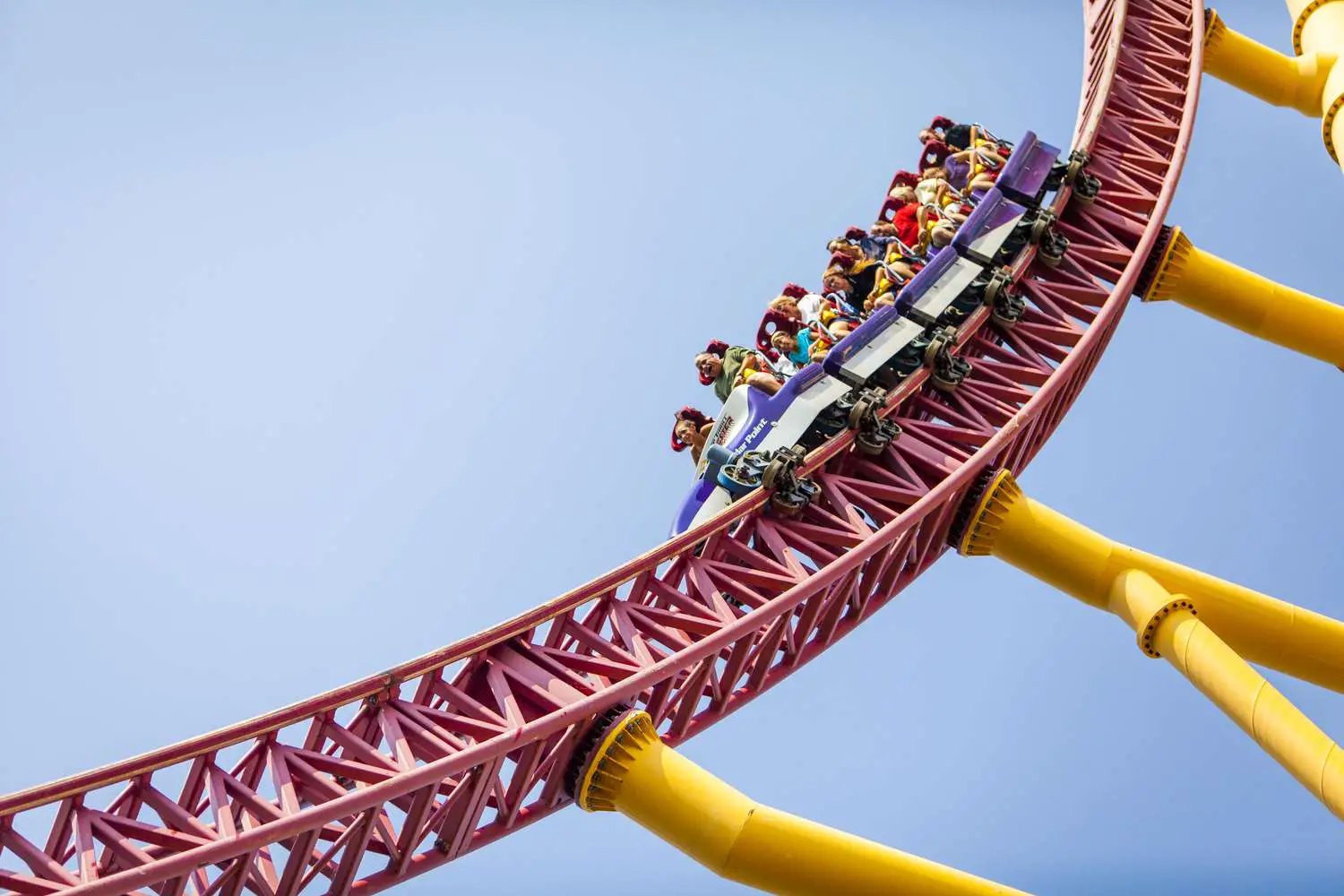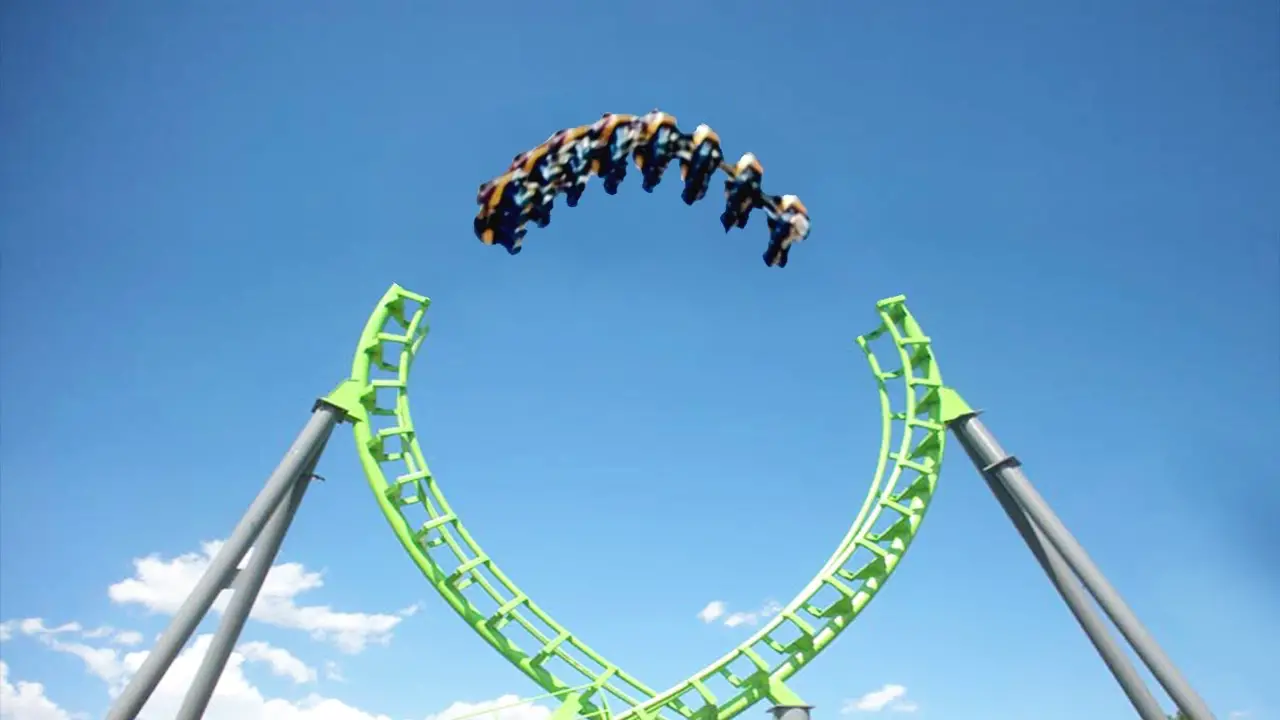Table of Contents
Feel your pulse quicken, and your breath catch as you prepare for the exhilarating rush that only a roller coaster can provide. Enter a realm where reality blurs with adrenaline-fueled fantasy, where gravity is defied, and where heart-pounding excitement is the order of the day.
As your cart ascends slowly, savor the anticipation. At the peak, you are against the wind before the world whips into a high-speed blur beneath you. Every twist and turn, every rise and fall, is a celebration of thrill-seeking spirit, a testament to human ingenuity and the sheer joy of letting go. Welcome to the captivating world of roller coasters, a euphoric journey that promises to unleash your wildest screams and etch unforgettable memories.

But are roller coasters safe?
Roller Coaster Deaths Per Year Worldwide!
Every year, there are 120 average roller coaster-related deaths worldwide. The United States, which makes up 4.25% of the global population, records just 4 of these deaths annually.
Roller coasters are safe because based on The International Association of Amusement Parks and Attractions (IAAPA) conducts research and compiles statistics on amusement park safety. According to the IAAPA, the odds of being killed on a roller coaster are incredibly low – about one in 170 million. This figure means that for every 170 million riders, one could expect to see a single fatality on average.
The IAAPA’s research also shows that the odds of sustaining an injury on a roller coaster are relatively low, approximately one in 15.5 million. This statistic suggests that there might be one injury for every 15.5 million riders.
It’s crucial to note that these figures are averages and represent the overall risk across all roller coaster rides, considering both the most and least safe rides. The actual risk on any given ride could be higher or lower, depending on a wide range of factors, including the specific design and operation of the roller coaster, the rider’s health and behavior, and the effectiveness of the safety measures in place.
The study examined the incidence of fatalities associated with roller coasters in the United States over ten years, from 15 May 1994 to 14 May 2004. There were 40 recorded deaths in total, occurring in 39 separate incidents, with victims ranging in age from 7 to 77 years.
The data revealed that 73% of the fatalities, amounting to 29 deaths, were among the patrons of the roller coasters. The causes of these deaths were further analyzed, and it was found that 38% (11 out of 29) resulted from external causes such as falls or collisions. The majority, 62% (18 out of 29), were attributed to medical conditions that may have been induced or exacerbated by the roller coaster ride.
On the other hand, the remaining 28% of the fatalities, totaling 11 deaths, were employees. All these deaths were caused by injuries sustained while on duty.
It was also reported that there were four injuries for every 1 million visitors. This information helps to contextualize the risk associated with roller coaster rides. However, it should be noted that this figure includes non-fatal injuries as well.

Roller Coaster Injuries Statistics
- Soft-Tissue Injuries typically include damage to muscles, ligaments, and tendons. During the study, 29% of all injuries reported were categorized as soft-tissue injuries. This indicates that these are significant sources of roller coaster-related harm.
- Head and Neck Injuries: These injuries, involving trauma to the head, neck, or both, made up 28% of all injuries. This is roughly equivalent to the percentage of soft-tissue injuries, indicating a similar level of risk.
- Strains and Sprains: This category includes injuries resulting in overstretching or tearing of muscles and ligaments, representing 21% of all injuries. Strains and sprains were the most common type of injury reported, suggesting that the forces and motions involved in roller coaster rides often lead to these injuries.
- Cuts: 20% of injuries were cuts, and open wounds, usually from contact with sharp objects or surfaces.
- Broken Bones in Children: Notably, among the injuries sustained by children, 10% resulted in broken bones. This figure highlights the potential severity of roller coaster accidents for younger riders.
Roller coaster-related deaths and Healthcare Insurance
Roller coaster-related deaths can impact healthcare insurance in several ways, both for the individual and the amusement park operator.
For individuals, if an injury or health crisis leading to death occurs while on a roller coaster, the person’s healthcare insurance might come into play. Coverage will depend on the specific terms and conditions of the policy. Some healthcare insurance policies might cover emergency treatment and hospitalization costs if they result from a roller coaster accident. However, some policies may have exclusions for injuries or deaths caused by “risky activities,” which could include roller coasters depending on the policy’s wording.
For amusement park operators, they typically carry liability insurance. This insurance can cover legal costs and potential damages if the park is found responsible for an injury or death, such as through inadequate maintenance or operator error. In the case of a roller coaster-related death, the victim’s family might file a lawsuit against the park. If the park is found liable, its insurance might cover the associated costs.
It’s important to note that the specifics of insurance coverage can vary widely based on the individual policy, the circumstances of the injury or death, and the laws of the region where the incident occurred.
Moreover, frequent roller coaster-related injuries or deaths can affect the premium costs for amusement parks. Insurance companies may increase premiums or refuse coverage if a park has a high incidence of accidents, motivating parks to maintain rigorous safety standards.
Lastly, these deaths can indirectly influence public health policy and insurance regulations. They might prompt calls for stricter safety regulations for amusement rides, potentially leading to changes in how insurance companies cover individuals and businesses concerning amusement park accidents.
Roller coaster safety
Roller coaster safety is a crucial aspect of amusement parks worldwide. Given the high speeds, sharp turns, and steep drops typically involved in roller coaster rides, stringent safety measures are necessary to protect riders.
Here are critical aspects of roller coaster safety that are followed across the globe:
- Design and Engineering Standards: Roller coasters are designed and constructed to meet specific safety standards. These include considerations for structural integrity, the reliability of safety features, and the maximum forces exerted on riders.
- Maintenance and Inspection: Regular and safety inspections are integral to roller coaster safety. The frequency of these checks can vary, but they often occur daily. These inspections include checking for structural damage, ensuring restraints function correctly, and verifying that the ride’s safety systems are operational.
- Operation Protocols: Ride operators receive training to follow the correct safety procedures. These include verifying that all passengers are correctly secured, observing the ride while in motion, and knowing how to respond to emergencies.
- Rider Responsibility: Safety instructions are provided to riders before the ride starts, and riders must adhere to these guidelines. This includes keeping hands and feet inside the ride, using safety restraints correctly, and not riding if they have certain medical conditions or do not meet the height and weight requirements.
- Regulation and Oversight: Depending on the region, government or third-party oversight of amusement park rides may exist. These agencies can provide regulations for ride safety, inspect rides, and investigate accidents.
- Emergency Preparedness: Parks have plans to respond to emergencies, such as power outages, mechanical failures, or health crises among riders. This can include evacuation procedures, first aid and medical response capabilities, and communication systems.
While these general principles are found worldwide, the specific standards and regulations can vary significantly from one country or region to another. Many countries, such as the European Union, have stringent standards, while others may have less stringent regulations. However, the shared goal is always to ensure that riders can enjoy roller coasters with minimal risk.
Conclusion
Roller coaster rides, with their breathtaking speed, exhilarating twists, and gravity-defying drops, offer thrilling experiences cherished by millions worldwide. Yet, the safety of these rides remains paramount. While roller coaster-related fatalities, reported annually, are a stark reminder of the inherent risks involved, these incidents are relatively rare, considering the sheer volume of riders each year. The concerted efforts of ride designers, engineers, operators, and regulatory bodies strive to ensure a safe environment for thrill-seekers. These measures, along with rider responsibility and adherence to safety guidelines, are pivotal in mitigating risks. So, while the joy and thrill of roller coasters endure, it’s incumbent on all stakeholders – from operators to riders – to maintain and respect the rigorous safety protocols that help keep the thrill of roller coasters alive and the risks in check.
